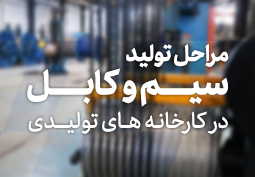
It could be said that wire and cable production follows a similar process across various factories, however, there are differences which we will explore in this article. We aim to clarify the production steps in manufacturing wire and cable within a factory.
Wire and Cable Production Steps
It could be said that wire and cable production follows a similar process across various factories, however, there are differences which we will explore in this article. We aim to clarify the production steps in manufacturing wire and cable within a factory.
The comprehensive product portfolio of Amol Wire and Cable Company is able to meet any needs and every customer requirement. Through the production of high-quality wire and cable, the company has established itself as a premier brand and has satisfied the customers' needs. The company takes pride in producing products that rival foreign counterparts while adhering to both domestic and international standards.
Step 1: Thinning
The thinning operation is performed by rod thinning and fine thinning machines in two steps. The rod machine begins the process by transforming 8 mm copper wire into 1.38 mm wire. Subsequently, this wire is fed to the fine machine which further refines the wire to meet factory specifications or customer orders.
Devices like the rod stretching machine are responsible for stretching and thinning copper wire to create the desired dimensions from the raw wires.
The stretching process takes place inside an oil-filled environment for lubrication, cooling, and cleansing purposes. The wires are then placed on the spools so they can be taken to the stranding stage.
Step 2: Annealing
All the wires produced in the previous stage with the fine machine undergo annealing. They are collected near the annealing furnace, once they reach a minimum amount, about 54 spools, they are ready to enter the annealing furnace. Annealed wires are then moved to the subsequent stages.
Step 3: Bunching or Twisting the Copper Strands
Bunching is carried out by a bunching machine. The annealed spools of wires from the previous stage are the raw materials for this step.
To manufacture multi-stranded cables like power cables or self-supporting cables, different strands must be twisted to form a uniform structure. This part is carried out by the twisting machine. In cables such as self-supporting cables, core strands are mainly intended to bear the cable weight and are positioned at the core. Other strands are spun around them with exact twist lengths and rotation directions.
Step 4: Insulation
The bunched strands serve as the primary raw material in the insulation stage. Insulating granules are another material used to form wire or cable insulation. The product is made by the extruder machine. The wires are sent to the relevant departments for packaging and the cable soles, are collected on special spools so they may be used in the sole twisting or stranding stage.
The Insulation process takes place inside the extruder machine. Extruders seamlessly inject PVC, XLPE, or semi-conductor materials as middle layers, insulation, or coatings. The materials pass through thermal elements and gradually melt inside the machine and exit the machine as a paste. Molds shaped according to the cable sizes are placed at the extruder's exit, ensuring the required thickness for various products.
The insulated cable cools in a water channel to reach ambient temperature and the cable is completely dried via airflow. Then the technical specifications and markings, such as the company name, cable size, standard sign, and year of manufacture, are imprinted onto the cable by a jet printer. Next, the cable proceeds to the take-up machine, where it is wound onto a spool.
Step 5: Covering
The covering is carried out by an extruder machine. The main raw materials of this stage include granulated soles, granules, coating materials, and talc powder.
In power cables, the strands spun inside the extruder machine must be coated with a layer of polyethylene or PVC material. This layer provides mechanical protection.
Step 6: Packaging
Packaging is the final step in the production process, where the final product is packaged according to specifications set by the customer. Generally, wires and cables can be delivered in coils or spools to the customers. Coil packaging is tailored to the customer's request and their preferred plastic type is used, however, in automatic vacuum packaging, the coils are packaged and vacuumed automatically by the machines.
Products may be wound onto wooden spools, or envelopes of various sizes according to customer requirements. When the plating and printing specifications are completed, the products are transferred to the final testing section. The spools used by different manufacturers may vary in material, such as wood or metal.
In this article, we tried to provide a complete and in-depth overview of wire and cable production. For further inquiries or to purchase products, feel free to contact our experts via the communication channels provided.


-px.jpg)

-px.jpg)